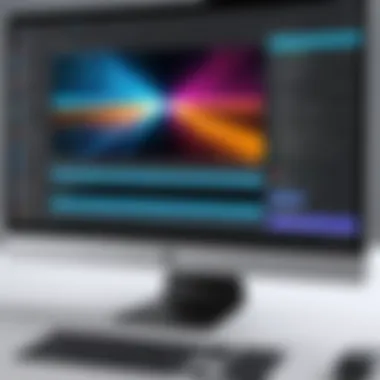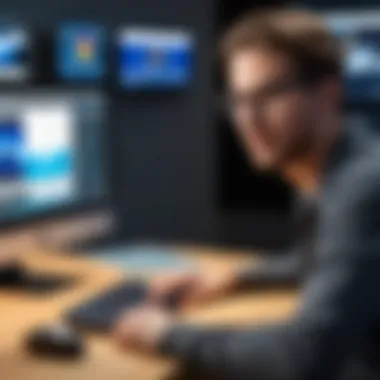Mastering Video Screen Capture Techniques and Tools


Intro
Video screen capture techniques have gained prominence in today's digitally driven landscape. As remote work and online interactions become the norm, the need for effective recording methods has surged. This guide is designed for IT professionals, software developers, and businesses of all sizes looking to enhance their screen recording skills. Understanding various tools and techniques not only improves communication but also aids in creating engaging content.
With the wide variety of software available, selecting the proper tool is crucial for achieving quality output. This guide will explore software options, essential system requirements, and strategies for maximizing screen capture effectiveness. By following this comprehensive framework, users can improve their workflow, enhance visual communication, and ensure their recordings are both informative and professional.
"Screen recording can simplify complex ideas and facilitate better engagement in any presentation."
The narrative unfolds in subsequent sections, capturing critical aspects of video screen capture to aid both beginners and experts alike.
Prelude to Video Screen Capture
Understanding video screen capture is essential in today’s visual communication landscape. This technique empowers users to effectively share content, allowing for clear demonstrations and presentations. With the surge in remote learning, online training, and digital marketing, mastering screen capture tools has become increasingly vital for professionals across various industries.
Definition and Importance
Video screen capture refers to the process of recording activity on a computer screen. This involves capturing visuals along with audio, making it a versatile tool for communication. The importance of screen capture extends beyond just saving what is seen on the screen. It serves as a foundation for tutorials, presentations, and even customer support. Rich, visual content aids in comprehension and retention, which is particularly important in educational settings.
Using screen capture means effectively highlighting essential information. Whether documenting software usage or creating engaging content for social media, clear video captures can greatly enhance understanding. The ability to visually convey information reduces ambiguity and ensures that the audience receives a full picture of the subject matter.
Applications of Screen Capture
The applications of screen capture technology are vast, touching various sectors and purposes. Here are some key areas:
- Education: Instructors can record lectures or tutorials, providing students with valuable resources to review.
- Software Development: Developers often create walkthroughs for applications, showcasing features and how to use them effectively.
- Marketing: Video demonstrations can be powerful tools for promoting products and engaging customers.
- Technical Support: Companies can provide visual support, allowing users to see solutions to their issues in real-time.
- Gaming: Streamers and gamers utilize screen capture to share gameplay and build communities.
Using screen capture in these scenarios not only saves time but also enhances learning and engagement. It is clear that the relevance of video screen capture is significant and continually growing. Individuals and organizations must invest time into understanding and utilizing these techniques to stay competitive and effective in their communications.
Understanding the Technical Requirements
In the realm of video screen capture, technical requirements are fundamental. Grasping the essential specifications helps ensure a smooth recording process and optimal output quality. Without such understanding, the user may encounter frustrating situations, such as lagging video or poor audio quality. This guide outlines critical components that users must consider, including hardware specifications and software compatibility. Awareness of these elements does not only mitigate risks but also enhances the overall effectiveness of video capture endeavors.
Hardware Specifications
Hardware plays a crucial role in the screen capture experience. It dictates the performance quality of recordings and influences the smoothness of the operation. Here are some key specifications to evaluate:
- Processor: A multi-core processor, such as Intel i5 or better, is recommended. This ensures that the software runs efficiently, especially when recording high-resolution content.
- Memory (RAM): At least 8GB of RAM is essential for decent performance. For advanced tasks or recordings at higher resolutions, 16GB or more is advisable.
- Graphics Card: A dedicated graphics card can significantly improve rendering and recording speeds. This is particularly important if screen capture involves high-quality gaming or graphic-intensive applications.
- Storage Space: Ample storage is necessary to save large video files. Solid State Drives (SSDs) are preferable over traditional hard drives for faster read and write speeds.
These specifications are vital for effective screen captures. Users should ensure their hardware meets these recommendations before beginning any project.
Software Compatibility
The relationship between hardware and software is paramount. Compatibility determines not just the installation but also the operational efficiency of screen capture tools. Here are several aspects to consider when evaluating software compatibility:
- Operating System: Ensure that the software supports the specific operating system in use, such as Windows, macOS, or Linux. Some software has distinct versions optimized for different systems.
- Resource Usage: Some screen capture programs are resource-intensive. It's vital to select software that aligns with the capabilities of the hardware to avoid slowdowns.
- Integration with Other Tools: Certain software works better with additional programs, like video editing tools or streaming software. Knowing what works well together can enhance productivity.
- Updates and Support: Look for software that offers frequent updates and robust customer support. This ensures that the user can tackle any emerging issues quickly.
Understanding hardware specifications and software compatibility not only prepares users for successful screen captures but also helps in troubleshooting potential issues that may arise during the process.
Choosing the Right Screen Capture Software
Choosing the right screen capture software is a vital step in ensuring you can effectively record high-quality video content. The software you select can greatly influence the functionality, ease of use, and output of your screen recordings. Different users have varied needs that these programs must address. Some may look for basic functionalities, while others require advanced features. Understanding these dynamics is essential for making an informed decision.
Free vs Paid Options
When evaluating screen capture software, a primary consideration is whether to opt for free or paid options.
- Free Software: These applications are a good starting point, especially for beginners or those with basic recording needs. They often provide essential features without any cost. However, limitations may include watermarks, restricted recording times, or lack of advanced features. Examples include OBS Studio and ShareX.
- Paid Software: Investing in paid screen capture tools typically offers greater functionality and flexibility. Paid options often come with customer support, frequent updates, and additional features such as advanced editing tools, cloud storage, and integration with other software. Examples include Camtasia and Snagit. While they require a financial commitment, the benefits might outweigh the costs for professionals needing high-quality content.
Key Features to Consider
Not all screen capture software is created equal. Here are key features to evaluate when choosing the right application:
- User Interface: A clean and intuitive interface can significantly enhance the user experience.
- Recording Quality: Look for tools that support high-definition recording.
- Editing Capabilities: Built-in editing features can save time and effort post-recording.
- Audio Capture: Consider whether the software allows for system audio and microphone input.
- File Format Options: Ensure it supports various output formats for compatibility with different platforms.
- Customization: The ability to select specific regions of the screen, add annotations, or incorporate webcam footage can enhance your recordings.


Popular Tools Overview
Several tools stand out for their features and usability. Here's a brief overview of some popular options:
- OBS Studio: Open-source and free; widely used for its flexibility and feature set, including live streaming capabilities.
- Camtasia: Paid software ideal for professionals, offering robust editing tools and multimedia elements.
- Snagit: Great for capturing still images and screen recordings with simple editing features, catering to business users.
- ShareX: A free tool known for its extensive options and customization, suitable for tech-savvy users.
Choosing the right screen capture software directly impacts the efficiency and effectiveness of your recording tasks. An informed choice will help you create quality content that meets your specific needs.
Installing Screen Capture Software
Installing screen capture software is a critical step in the video recording process. The right installation lays the groundwork for effective screen capturing, allowing users to produce high-quality videos. Understanding how to properly install this software can also prevent common pitfalls that might arise during the recording phase. Thus, familiarity with the installation process is essential for anyone aiming to enhance their screen capture skills.
The significance of this component cannot be overstated. Whether you are a professional video creator or a casual user, starting with an optimal installation sets the stage for a seamless experience. Proper installation processes can reduce software errors and improve overall performance. It can also ensure that your system is fully compatible with the chosen software, which is vital for maximizing functionality and capabilities.
Step-by-Step Installation Guide
- Choose Your Software: Begin by selecting the appropriate screen capture software that meets your needs. Popular options include OBS Studio, Camtasia, and Snagit. Each has different features, so consider what is most important for your use case.
- Download the Installer: Navigate to the official website of the software you selected. Locate the download link and ensure you are downloading the latest version compatible with your operating system, whether it’s Windows, macOS, or another platform.
- Run the Installer: After downloading, locate the installer file in your downloads folder. Double-click the file to initiate the installation process. You may be prompted by a security warning; confirm that you want to proceed to continue.
- Accept the License Agreement: Review the End User License Agreement (EULA). If you agree to the terms, check the relevant box and click on the 'Next' button.
- Select Installation Type: Some software will offer different installation options such as Standard, Custom, or Advanced. Choose the option that aligns with your technical comfort level. For most users, the Standard installation will suffice.
- Choose Installation Directory: You may be asked to select where you want to install the software. Unless you have specific preferences, it’s usually best to go with the default directory.
- Complete Installation: Click the 'Install' button. The installation process may take a few minutes. Once finished, you will see a confirmation screen. Click 'Finish' to exit the installer.
- Check for Updates: Upon launching the software for the first time, it’s wise to check for updates. This ensures you have the latest features and security enhancements.
- Restart Your Computer (if necessary): Some software installations may require a system restart. If prompted, restart your system to finalize the installation process.
Important: Always ensure your antivirus or firewall settings allow the app to function properly, as these can sometimes block essential operations after installation.
By following these steps meticulously, users can avoid common errors and prepare their systems for an effective screen capture experience. The right software, paired with careful installation, greatly impacts the quality and usability of video recordings.
Configuring Screen Capture Settings
Configuring screen capture settings is a critical aspect of achieving high-quality video recordings. These settings allow users to tailor their capture process to numerous factors such as the content being recorded, the target audience, and the intended use of the final product. Proper configuration can greatly enhance clarity, reduce file size, and optimize playback. In this section, we’ll explore various elements that come into play when setting up your screen capture.
Screen Resolution and Frame Rate
Screen resolution refers to the number of pixels displayed on the screen. Higher resolutions offer clearer images and are better suited for detailed content, like software tutorials or gaming. Common resolutions include 1080p (1920x1080) and 4K (3840x2160). Choosing an appropriate resolution is essential. If the resolution is too low, the final video might look pixelated and unprofessional.
Another pivotal aspect is frame rate, which is the number of frames displayed per second. Standards include 30 frames per second (fps) for general use, while 60 fps is recommended for fast-paced content, such as gaming or dynamic presentations. When configuring, strike a balance between quality and file size. High resolution and frame rates yield larger files, requiring more storage and bandwidth for sharing.
Audio Settings
Audio quality can significantly affect the viewer's experience. Proper audio configuration includes choices about microphone input, sound levels, and background noise reduction. Start by selecting the correct audio input device. A dedicated microphone is preferable to built-in laptop microphones, which often pick up background noise.
Consider using settings that allow for sound testing before recording. Verify levels to avoid distortion or inaudible sound. Many screen capture software options provide features like noise suppression to enhance audio clarity. Having robust audio settings is paramount as it can elevate even average video content by ensuring that the viewers grasp the full message.
Recording Area Selection
The recording area encompasses the on-screen region that will be captured. Users can choose the entire screen, a specific application window, or a custom region. The selection should be deliberate and relevant to the content.
If recording tutorials, highlighting the application window is often more effective than capturing the entire screen, as it minimizes distractions. Ensure any unnecessary browser tabs or applications are closed to keep the focus on the primary content. For optimal results:
- Decide the recording area based on content relevance.
- Adjust the window size prior to recording to ensure clarity.
- Use markers or outlines within the recording software to help emphasize important sections after editing.
Executing a Screen Capture
Executing a screen capture is a pivotal aspect of creating quality video content. This process brings together the technical specifications, the chosen software, and the creative vision behind the material being recorded. Focusing on this area ensures that your final output meets professional standards, whether for tutorials, presentations, or documentation. Proper execution can enhance the effectiveness of your communication, making it clearer and more engaging for your target audience.
Pre-Recording Checklist
Before hitting the record button, it is essential to have a solid pre-recording checklist. This checklist serves to minimize potential errors and enhance the quality of the final video. Key items to consider include:
- System Performance: Ensure your computer's CPU and RAM can handle the software and recording process simultaneously. Close unnecessary applications to free up resources.
- Screen Resolution: Set your display to a resolution that balances clarity and file size. Common choices are 1920x1080 or 1280x720.
- Recording Area: Decide on whether you want to capture the entire screen or just a specific application window. Ensure the selected area is free from distractions.
- Audio Setup: Check your microphone and system audio settings. Make sure the audio levels are balanced and the right input device is selected. It may be beneficial to record a test sample.
- Backdrop and Environment: Ensure a clean and professional backdrop if you're recording face-to-face alongside your screen. Clear any personal items in the view.
"Thorough preparations lead to a smoother recording experience and enhance output quality."
Recording Process
Once preparations are complete, it is time to dive into the recording process. This phase can heavily influence the accessibility and appeal of the content. The following steps are vital during this part:
- Launching the Software: Open your chosen screen capture software and configure the settings according to your earlier checklist. Select the desired resolution, frame rate, and audio sources.
- Starting the Capture: Use the designated hotkey or button within the software to initiate the recording. Familiarize yourself with these controls prior to starting.
- Engagement: While recording, maintain a clear and steady pace. Speak clearly and directly to your audience as if they are present. This adds a personal touch.
- Monitor Performances: Keep an eye on the recording status. Some software offers visual indicators. Adjust settings on-the-fly if needed, but avoid unnecessary interruptions.
- Ending the Capture: Once the content is complete, properly end the recording. Most tools offer a simple stop button. Ensure you save the file correctly to avoid any data loss.
Editing Recorded Videos


Editing the recorded videos is a crucial process in the overall screen capture workflow. Once you have captured your video, the raw footage often requires some refinement to meet professional standards and enhance viewer engagement. Improper edits can detract from the message you wish to convey, making it essential to dedicate time to editing.
The benefits of editing recorded videos are numerous. First, editing can improve the clarity of your message by removing unnecessary content, which allows the essential elements to shine. Second, it provides an opportunity to add context through text overlays, annotations, or even supplementary visuals. Third, well-edited videos are more likely to hold the audience's attention, as they feel more polished and dynamic.
Considerations in the editing process include the target audience and the platform where the video will be shared. Different social media platforms have varied requirements, affecting how the content should be optimized. Thus, understanding those needs will help in tailoring the editing approach effectively.
Basic Editing Tools
Editing videos requires specific tools, and the choice of software can significantly shape your editing experience. Basic editing tools allow you to perform essential functions such as trimming, cutting, and merging clips.
Some of the well-known tools include:
- Adobe Premiere Pro: Offers advanced features like multi-cam editing and rich effects.
- Camtasia: Designed specifically for screen recording, it includes easy-to-use editing capabilities.
- Windows Movie Maker: A user-friendly option for simple edits.
- iMovie: Suitable for Mac users looking for straightforward editing features.
While free tools may suffice for basic edits, investing in more advanced software can elevate your final product, especially for professional use.
Enhancing Video Quality
While recording settings and the hardware used contribute significantly to video quality, post-production enhancement plays a pivotal role as well. Enhancing video quality involves adjusting various parameters to create a more visually appealing output.
- Color correction: Adjusting brightness, contrast, and saturation can lead to a more vibrant appearance.
- Audio normalization: Ensuring audio levels are consistent improves viewer experience.
- Stabilization: Correcting shaky footage enhances professionalism.
By focusing on these enhancements, you can considerably improve audience engagement and convey your message more effectively.
Export Formats and Options
Once the editing process is completed, determining the appropriate export format is an important step. Different formats serve distinct purposes and platforms.
Common export formats include:
- MP4: Highly compatible across various platforms, ideal for web use.
- AVI: A larger file size but retains more quality, suitable for detailed projects.
- MOV: Preferred for high-quality video, especially in professional settings.
Considerations for export include balancing quality and file size, which is crucial if you plan on sharing the content online or via email. Choosing the right settings ensures that your content is accessible while maintaining the necessary quality.
Successful editing bridges the gap between the raw video and the final product, defining how the audience perceives the information presented.
Sharing and Distributing Screen Captures
Video screen capture not only allows you to create content but also requires careful thought regarding how it will be shared and distributed. This topic is vital as it influences who can access your content and how effectively it can reach audiences. Choosing suitable platforms and optimizing your videos for those platforms can greatly enhance viewer engagement and satisfaction. Important elements to consider include audience demographics, platform characteristics, and your specific goals for the video.
Platforms for Sharing
Numerous platforms exist for sharing screen captures. Each platform has its own strengths and can cater to different audiences. Here are some popular options:
- YouTube: This platform is ideal for reaching a wide audience. It supports various video formats and provides robust analytics for performance tracking.
- Facebook: Shares can be made easily on this social media site, making it suitable for community engagement.
- Vimeo: Known for its high-quality video hosting, Vimeo caters more to professionals and creatives looking for customizable options.
- LinkedIn: This professional network is suitable for educational content and tutorials aimed at a business audience.
- Twitch: While primarily a live-streaming platform, Twitch can be a good option if you're creating gaming content or interactive tutorials.
- Reddit: This allows for niche sharing based on subreddits; it can drive highly targeted traffic to your videos.
Each platform comes with its own requirements regarding file size, format, and length limitations, necessitating careful attention while distributing your screen capture videos.
Optimizing Video for Different Platforms
To achieve the best results when sharing your videos, you must optimize them according to the specific platform they will be on. Optimization involves several factors:
- Video Resolution: Each platform has recommended resolutions. For instance, YouTube often suggests 1080p for optimal viewing. Reducing quality for faster buffering on limited bandwidth might be necessary for some users.
- Aspect Ratio: Varying platforms have different aspect ratio standards. For instance, Instagram supports square videos, while YouTube favors 16:9.
- File Format: The most compatible file formats are MP4 and MOV. These formats balance quality and compatibility on most platforms.
- Length of Video: Not all platforms cater to long videos. For example, TikTok videos are short-form, whereas Vimeo and YouTube can accommodate longer length formats. Shorter, engaging content might perform better on social media.
- SEO Considerations: Use relevant keywords in the title, description, and tags of your videos. This practice increases visibility in search results.
- Thumbnails: Create compelling thumbnails that catch the eye. Thumbnails play a significant role in click-through rates.
"Optimization is more than just ensuring your video plays; it's about maximizing the viewer's experience and response to the content."
By paying attention to these specifics and adjusting your videos accordingly, you can ensure better engagement and reach across diverse platforms, ultimately promoting your content more effectively.
Common Challenges in Screen Capture
The process of video screen capture is not devoid of complications. Understanding the common challenges can enable individuals and professionals to preemptively address them, thus enhancing the overall efficacy of capturing tutorials, presentations, or software demonstrations. This section evaluates technical issues and quality concerns that often surface during screen recording processes. Recognizing these obstacles is important because it facilitates more informed decisions and choices regarding software and techniques.
Technical Issues


Technical issues in screen capture can manifest in various forms. These problems may range from software glitches to hardware limitations that hinder smooth recording experiences. Here are some key aspects to consider:
- Compatibility Conflicts: Some software may not operate well with specific operating systems or other applications. Research is essential to ensure that your chosen screen capture software works seamlessly with your current setup.
- Hardware Limitations: Screen captures are resource-intensive tasks that necessitate adequate hardware specifications. Low RAM, weak processors, or insufficient graphics capabilities can induce lags or crashes during recording sessions. It is advisable to review hardware requirements before installation.
- Frame Rate Drops: A common issue arises when the screen capture software cannot maintain a consistent frame rate. This inconsistency can lead to choppy recordings. Ensuring that the recording frame rate matches the display can help mitigate this issue.
"Being aware of potential technical pitfalls is vital for preventing disruptions during a recording session."
- Audio Synchronization Problems: Another technical hurdle involves ensuring that audio aligns perfectly with video. Delays or out-of-sync audio can detract from the viewer's experience. To combat this, test your audio settings prior to capturing.
Quality Concerns
The quality of the recorded output is paramount. Various factors can influence video quality, and addressing them is essential for producing professional-grade content. Key quality concerns include:
- Resolution Settings: Recording in the improper resolution can severely affect the clarity of the video. It's crucial to select a resolution that not only meets the target audience's viewing preferences but also matches the display settings of the content being captured.
- Visual Artifacts: Compression artifacts can distort videos. These are often the result of aggressive encoding settings or low-quality capture specifications. A careful balance between file size and quality is crucial to ensure a clean output.
- Lighting and Screen Clarity: Poor lighting conditions or a cluttered desktop can affect the visual appeal of a screen recording. Always aim for well-lit environments and a tidy workspace to enhance the professionalism of your video.
- Editing Quality: After recording, editing plays a vital role in improving video quality. Using effective editing tools can significantly enhance the final product. Consider investing time in mastering basic editing techniques to elevate your screen captures.
Addressing these challenges can seem daunting. However, an understanding of potential pitfalls allows for better preparation and ultimate success in the screen capture process.
Case Studies of Effective Screen Captures
In the realm of video screen capture, understanding real-world applications and outcomes is vital. Case studies serve as an illuminating guide through practical use, demonstrating best practices in a variety of contexts. They highlight the effectiveness of screen capture techniques, showcasing how different industries adapt and implement these tools to solve unique challenges. The richness of these examples helps to clarify the significant impact that effective screen capture can have on improving communication, training, and content delivery.
The benefits of analyzing successful case studies include:
- Practical Insights: Provides concrete examples that can be modeled or adapted.
- Varied Applications: Showcases how different fields utilize screen capture technologies.
- Performance Metrics: Assists in understanding the tangible outcomes from using these methods.
- Problem-Solving: Offers solutions to common challenges faced during screen capture processes.
Case studies allow IT professionals and businesses to not only observe the effectiveness but also contemplate how to incorporate similar strategies. By exploring documented results, professionals can learn from the experiences of others, avoiding pitfalls while leveraging effective methods.
Successful Examples from Various Industries
Several industries have successfully integrated screen capture into their regular practices:
- Education: Many educational institutions utilize screen capture for online courses. For example, a university developed a series of video tutorials that allowed lecturers to record their lectures and share them with students. This approach not only enhanced student understanding but also provided a flexible learning resource. Educators could visually demonstrate complex concepts, allowing for a better grasp of the material.
- Software Development: Tech companies often use screen capture for product demos and troubleshooting. A notable instance is a leading software firm that employed screen capture videos to illustrate updates in their application. By doing this, they efficiently communicated new features to current users, reducing support inquiries and increasing satisfaction.
- Digital Marketing: Marketers often capture screens to create how-to videos or customer testimonials. A successful digital marketing agency produced a video series showcasing customer journeys. This series helped the agency communicate the value of their services, resulting in higher engagement and conversion rates.
- Healthcare: A healthcare organization adopted screen capture for internal training and compliance. By recording training sessions and protocols, they ensured that all staff had access to consistent and up-to-date information, which improved adherence to practices and ultimately enhanced patient care.
- Gaming Industry: Game developers use screen capture extensively for promotional purposes. One prominent game studio showcased their upcoming release through a series of recorded gameplay highlights. These videos sparked excitement among potential players and generated significant pre-launch interest.
In examining these examples, the implications of effective screen capture become clear. It serves not just as a tool for recording, but as a means to enhance information dissemination and foster engagement across various sectors. With careful implementation, the potential for video screen capture to improve processes and communication remains substantial.
Future Trends in Screen Capture
Screen capture technology is evolving rapidly, driven by user needs and advancements in digital tools. Understanding these future trends is essential for any professional engaged in video production or content creation. Highlighting these advancements allows individuals and businesses to stay relevant as technology changes.
One key aspect is the increase in cloud-based solutions. These platforms enable users to capture and edit videos without high-performance hardware. This means smaller companies can compete with larger organizations by lowering their equipment costs. Additionally, cloud solutions facilitate easier collaboration between teams in different locations, a significant consideration in today’s remote work environment.
Another emerging trend involves the rise of AI-driven tools. Innovations in artificial intelligence are streamlining not only the recording process but also editing and post-production tasks. Tools can now analyze captured footage to suggest cuts, detect unwanted noise, or even enhance visuals automatically. This trend reduces the time needed for video processing, allowing creators to focus on content instead of technical fixes.
Real-time collaboration is also gaining traction. As multiple users can now join sessions online to capture screens simultaneously, instructional videos and tutorials benefit greatly from this trend. This feature is valuable in remote education and training environments, where user interaction enhances the learning experience.
"As technology advances, staying updated with video screen capture trends ensures that your content remains relevant and engaging."
Increased compatibility across devices and platforms is another trend to note. Users now seek solutions that work seamlessly on desktops, tablets, and smartphones. This adaptable approach caters to varying preferences and work environments, further democratizing access to screen capture technology.
Emerging Technologies and Innovations
The landscape of video screen capture is changing swiftly, with emerging technologies reshaping how content is created. The development of 4K and 8K resolutions allows users to produce high-quality videos, capturing intricate details. Greater resolution ensures clarity, which is crucial for tutorials or demonstrations where details matter.
The introduction of virtual and augmented reality (VR and AR) influences video capture methodologies. These technologies provide immersive experiences that engage users more deeply. For example, software that allows users to record AR experiences can change educational and training presentations significantly.
Adaptive streaming technology is enhancing how videos are shared and consumed. By automatically adjusting video quality based on the user's internet speed, this feature ensures smoother playback. It caters to users with varying bandwidth, enhancing accessibility across diverse contexts.
Finally, developments in privacy and security will play an essential role. As more individuals work remotely, concerns about data protection grow. Future screen capture tools are likely to include robust features that safeguard captured content, ensuring compliance with regulations like GDPR. This focus on security will be critical for businesses sharing sensitive information.
Investing attention to these technologies and trends can significantly impact the effectiveness and professionalism of screen capturing efforts. Technology not only drives efficiency but also defines content quality and user engagement.
Finale
The conclusion of this article is essential in synthesizing the various elements of video screen capture discussed throughout. It provides clarity on the significance of mastering screen capture techniques, which are vital not only for individual use but also for businesses and educational institutions. Effective screen capturing allows for better communication, knowledge sharing, and documentation. This summary brings together critical insights that can enhance the understanding and application of screen capturing methods.
Summary of Key Takeaways
In summary, several points are critical:
- Importance of Technical Knowledge: Understanding hardware specifications and software compatibility is fundamental to achieving quality screen recordings.
- Choice of Software: Selecting the right screen capture software can dramatically influence the outcome. Both paid and free options have specific advantages.
- Editing and Distribution: Post-capture editing is essential for refining the final product. Knowing how to share and optimize videos across different platforms is equally important.
- Awareness of Challenges: Being aware of common challenges, such as technical issues and quality concerns, is crucial in preemptively addressing potential problems.
It is worth noting that the mastery of these techniques can greatly influence the effectiveness of communication, enhance training materials, and bolster collaboration efforts across various sectors. Engaging with this content arms professionals and companies alike with the tools necessary to create engaging, quality video outputs. By integrating advanced practices as outlined in this guide, users can elevate their video screen capture efforts to a professional level.



